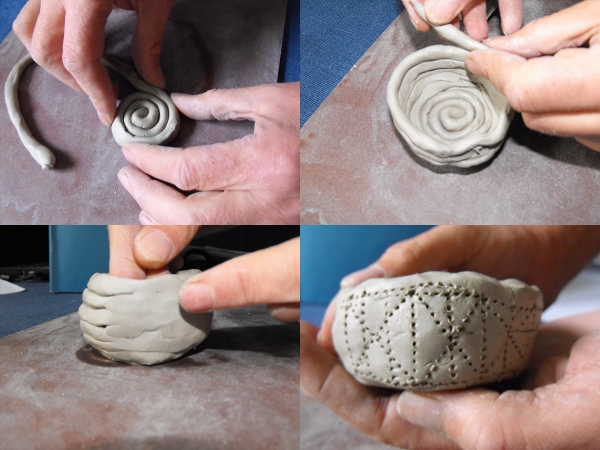
Coil, build, smooth, decorate; the four stages of building a coil pot, inspired by prehistoric pottery excavated locally. This is one of the activities you can take part in at Archaeology for You in the Inspired by the Past area on Saturday.

Coil, build, smooth, decorate; the four stages of building a coil pot, inspired by prehistoric pottery excavated locally. This is one of the activities you can take part in at Archaeology for You in the Inspired by the Past area on Saturday.
Only three days left to go until Archaeology for You on Saturday the 12th July at the Powell-Cotton Museum. One of our activities on Saturday will be ‘Give it a Swirl’ where you can find out how archaeologists find out about evidence for ancient environments and diets from soil samples taken at dig sites.
Today’s picture is of some charred grain, seeds, charcoal and tiny shells that were found in a soil sample taken from a Medieval ditch near Manston.
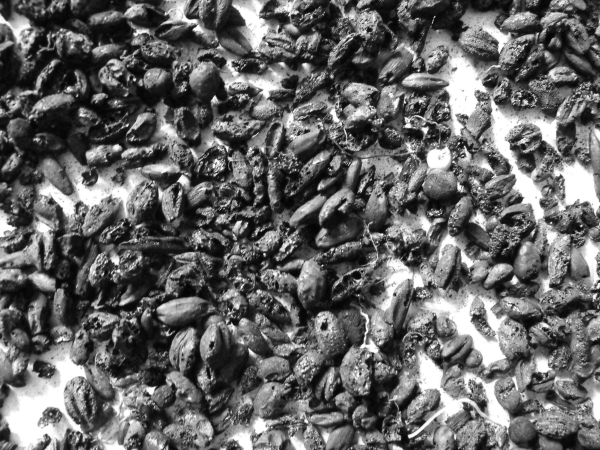
The process we use to retrieve this evidence is called flotation. This is where soil samples are swirled in water in a tank over a fine mesh. The light artefacts such as charred seeds and grain, charcoal and small bones float to the top and are retrieved for identification by pouring the water off through a fine seive. Heavy artefacts such as the odd stone, piece of pot or larger bone sink and are retained by the fine mesh and the soil particles sink right to the bottom of the tank.
We will be using a simplified version of this process on Saturday using buckets and plenty of water, so come along, get your hands dirty and Give it a Swirl!
Re-creating the lifestyles of the past is one of the ways that we study the objects discovered by archaeological investigation. Objects and personal items that have been found together in well dated layers on archaeological sites have been carefully recorded and studied to build a picture of all the things that were used or worn at a specific time.
Using the evidence recovered from excavations, authentic objects and costumes from a particular time in history can be reconstructed. By recreating the costumes, household items and clothing of the past and using them to re-enact processes and encounters that were experienced in the past, archaeologists gain an insight into life as it was lived.
Changes in the styles and functions of the objects let us trace changes in fashion and style, but also point out sharp breaks and changes in ways of life, which are important to our understanding of history.
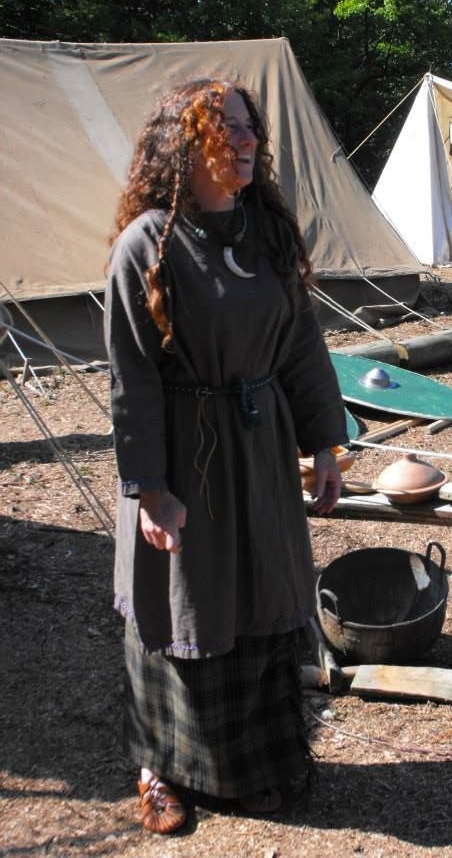
De Bello Canzio are a re-enactment group that explore the changing world of the Cantiaci, the people Julius Caesar records as living in Kent in the Iron Age. One of the significant changes to the life of the Cantiaci came when the Roman armies invaded and occupied the Island of Britain in 43 AD. 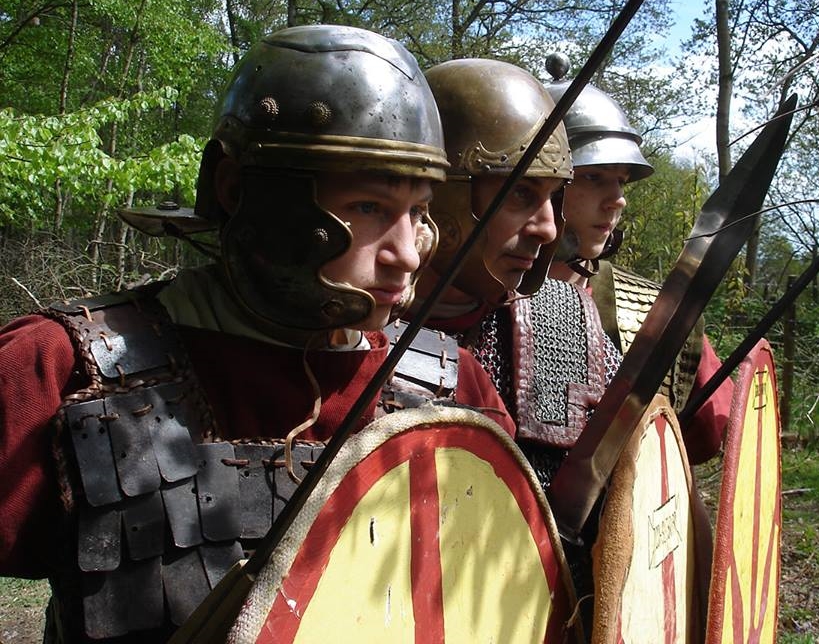
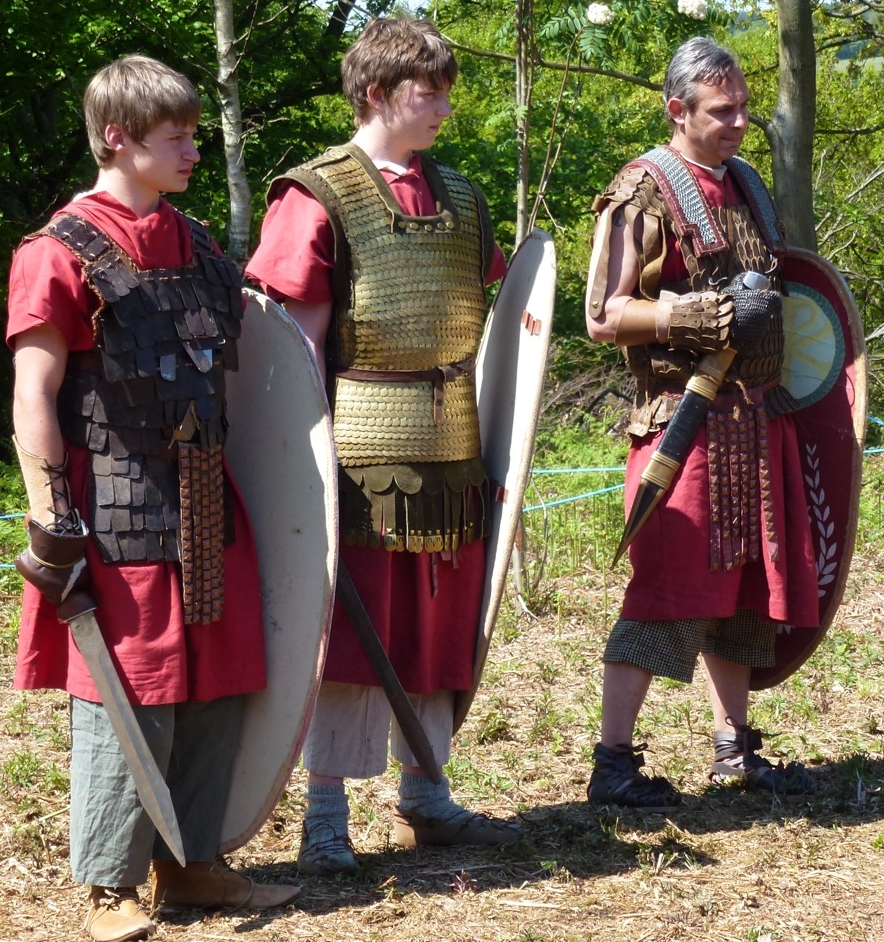
Many of familiar patterns of dress and objects that were used by the Cantiaci before the Roman invasion lived on for a time, but the range of costumes, equipment and household items changed significantly after the Roman invasion.
Through their displays and costumes De Bello Canzio bring a glimpse of the life of the Iron Age and Roman Cantiaci to the re-living ancient life area at Archaeology for You.
Welcome to Day 2 of the Virtual Museum 365 project.
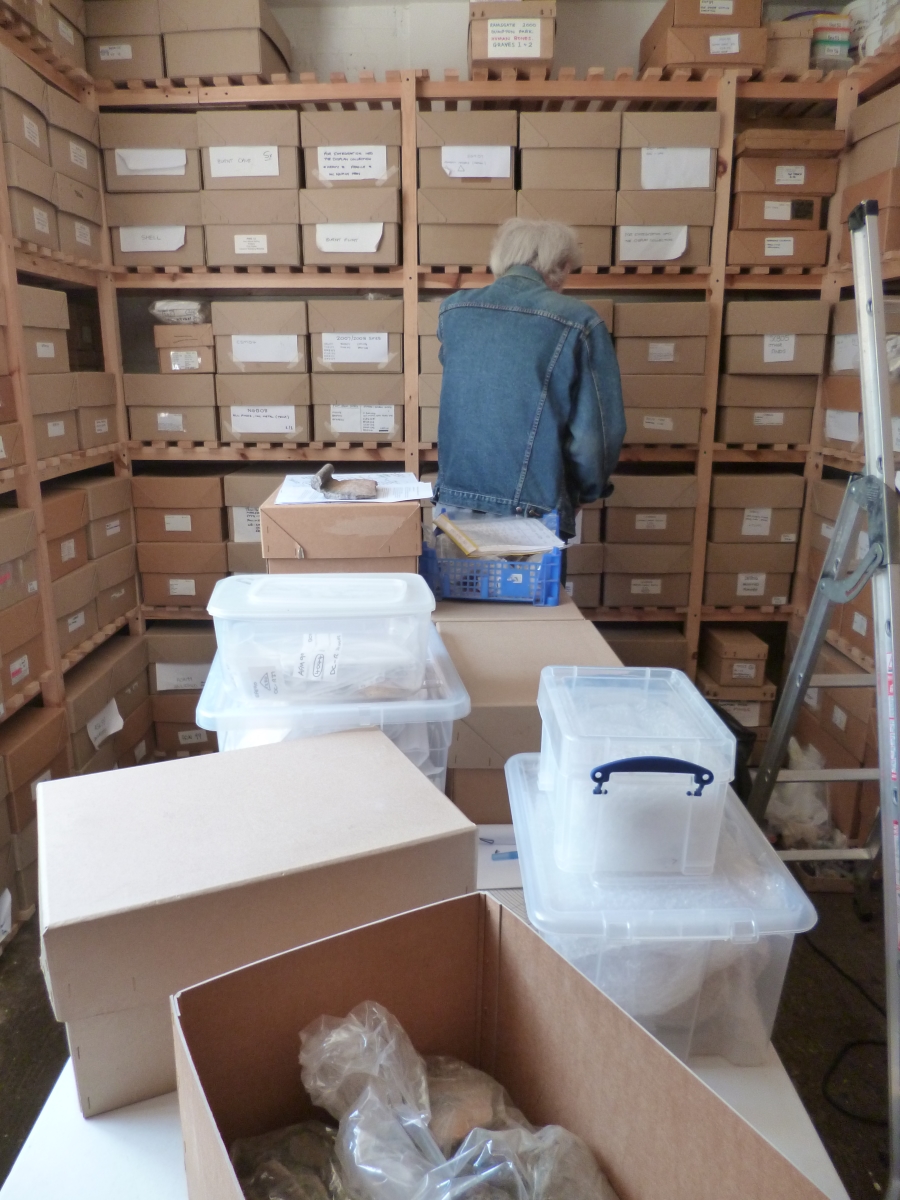
Today’s picture is of archaeological ceramics specialist Nigel Macpherson-Grant working in our store, sorting through boxes of prehistoric pottery from past sites. Nigel is creating an exemplary collection of Thanet’s ceramic material which we will use in the Virtual Museum for teaching, display and handling collections. You will be able to see and handle some of it at Archaeology for You on 12th July.
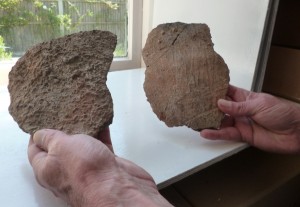
The two sherds of pottery shown above were in one of the boxes Nigel was looking at. They date to the Early to Middle Iron Age, between 550-400 BC and are known as rusticated coarsewares, because of the treatment of their surfaces. They were found in the Fort Hill area of Margate.
Our VM_365 project will present one image a day, each day for the next year, on themes 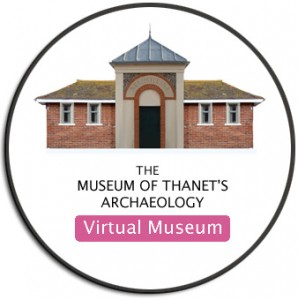 related to our Virtual Museum of Thanet’s Archaeology.
related to our Virtual Museum of Thanet’s Archaeology.
As archaeologists we often have a camera handy to record those unexpected moments when something new emerges from the ground, or from our collection of artefacts. Whether its capturing an image outdoors on a site, or in one of the darker recesses of the museum storage boxes or having the opportunity to take a fresh look at something we take for granted, we will post an in image in our project each day.
Choosing the image we post each day will be a chance to stretch our imagination in illustrating the world of archaeology and our important local heritage. Over the course of the year we may develop themes with a series of pictures, or just take a one off chance to explore a subject.
We have some ideas in mind already of images we want to show, others will come to us as the project goes on. Some of our images may be taken quickly, capturing a valuable moment as the opportunity arises and some will use the rich resources of images we have in our archives. Whatever the circumstances the project will present something interesting, fun and thought provoking each day.
Check in through our Twitter and FaceBook pages, or here on our journal where you will find more notes or detailed background to the images.
We would love to have your feedback and comments on the images over the duration of VM_365, we start today!
The first image we would like you to see is the new VM_365 logo which will accompany the images over the year. Like it?

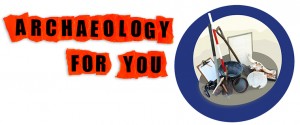
Archaeology for You is the Trust’s annual event to celebrate the National Festival of Archaeology, which is organised each year by the Council for British Archaeology. Once again in 2014 Archaeology for You will be held in the Gardens of the Powell-Cotton Museum, on Saturday the 12th of July from 10am to 5pm.
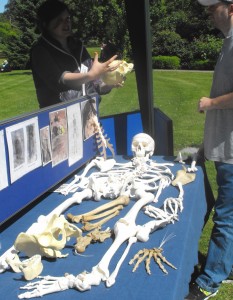
If you ever wonder how archaeologists can say what they do about the past, you can find out at Archaeology for You. There are many hands on activities demonstrating the principles and methods of archaeological investigation, exploring digging methods, site recording and the process of reading the evidence of the finds from a site, giving you the basics of archaeological investigation.
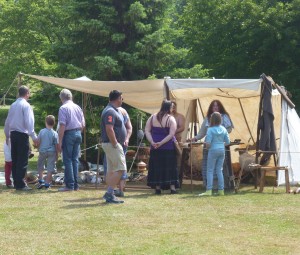
To bring to life the people of the past re-enactors from De Bello Canzio, a group specialising in Iron Age and Roman life, will show how archaeological evidence is used to explore costumes, tools, weapons to reconstruct the way of life of the Iron Age and Roman people.
There are no age limits to learning at Archaeology for You, there’s something for everyone in each of the activities from the youngest to the oldest.
The Trust for Thanet Archaeology is an education charity, with the mission to explore and explain archaeology. At Archaeology for You we bring together our experience as professional archaeologists with our education role, to demonstrate how archaeologists explore the world around them and use the evidence they gather to create historical stories by using archaeological techniques to investigate things and places.
Teachers exploring archaeology at school will find many ideas and resources at Archaeology for You that can be used in the classroom to help children understand how archaeologists investigate the world and reveal history from things and places.
Flyer and poster
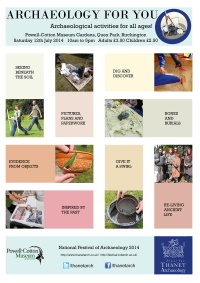
Download a Flyer or an A3 sized poster for Archaeology for You
Download the guide to archaeological activities for all ages
We would love to see you at Archaeology for You
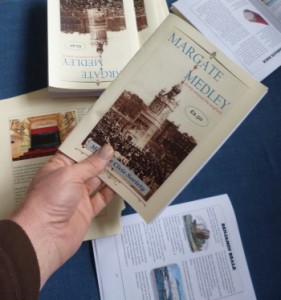
We’ve been able to use our publishing skills to help out with a project organised by Margate Civic Society,
A while ago we bought a nifty laser printer that is able to produce small booklets automatically, letting us produce short run publications for ourselves and others. Its a little labour intensive, as we have to fold and staple each copy by hand and then press them for a few hours. A bit of an old school publishing practice.
This week the Trust has been rolling out a new publication from our presses on behalf of the Margate Civic Society, printing and binding copies of a small publication called Margate Medley, packed with snippets from Margate’s history. It has a short article by the Trust’s Director on the history of Margate Pier, based on the talk she gave at our 25th Anniversary conference last year. There are many other interesting pieces on historical sites and events that have contributed to Margate’s unique character.
The book is for sale at £2.50 from Margate Civic Society, or at the Time Ball celebration events. Proceeds from the sales will support the Civic Society and their Fund Raising for the Time Ball project and other local activities.
The Trust were invited back to Upton School in Broadstairs on Wednesday 26th February for a day of archaeological activities for the school’s History day.
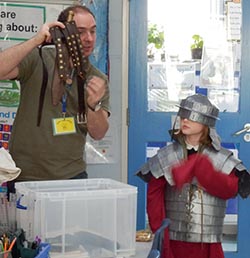
Adam and Lauren of the Trust ran four sessions on the archaeology of the Roman period over the day, starting with an overview of the history of Roman settlement in Britain and an experience of the everyday life of the Roman soldier, the first of the Roman people to arrive in Kent.
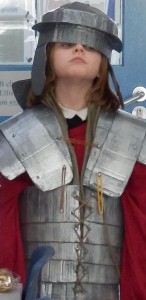
Volunteers from among the children didn’t just get a taste for the commitment to long service, but also had a sense of the gruelling routine of marching in full armour and a pack full of equipment; an experience that has been compared to carrying one of your friends around on your back with the weight of a frozen chicken on your head.
The archaeologists explained how the evidence for our understanding of Roman life is gathered from the remains that are left behind, and what a wide range of equipment to excavate, record and then report discoveries is needed.
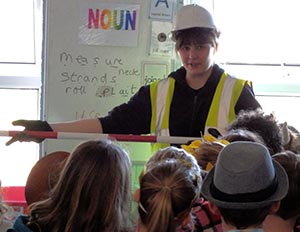
Eventually it was time for the children to Dig and Discover for themselves, excavating an artefact then carrying out their own analysis of the find using one of the Trusts specially designed recording sheets. Each of the junior archaeologists could have a first-hand experience of their Roman past from the real Roman objects that could be investigated and drawn.
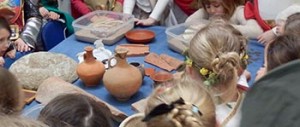
It wasn’t just the Roman period that got the archaeological treatment, our Anglo-Saxon skeleton activity and costume were put to use by the teachers. Using the skeleton and replica items, they could examine how investigation of the rich culture of Anglo-Saxon burials can teach us about this important period of our history.
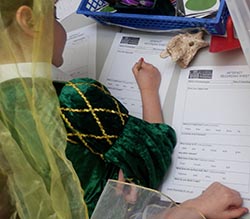
Our opportunity to introduce the children of Upton school to archaeological investigation has been a great way to use the rich resources the Trust has available and give a hands on experience of the past. We are grateful for the opportunity to share our interest with the next generation of archaeological investigators.
An interesting collection of studies has been added to the Anglo-Saxon section of the Trust’s archaeological library.
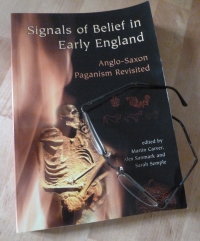
Edited by professor Martin Carver, Alex Sanmark and Sarah Semple, Signalsof Belief explores the history and character of ‘pagan’ Anglo-Saxon belief before and after Christian ideas began to spread after Augustine’s mission to covert the English arrived in 597 AD, The subject is significant to the archaeology of Thanet because of the number of important Anglo-Saxon cemeteries located on our chalk downland landscape. The Island would have been an important cultural community, linking the ideas of the people of north Germany and Scandinavia with what remained of the Roman world in Britain and on the continent.
Of course, Augustine’s mission sent by Pope Gregory the Great to convert the Anglo-Saxon kingdoms was one of the most significant events in the story of ideas and beliefs in the Anglo-Saxon period and, the 8th century historian Bede tells us, the first connections between the two cultures took place somewhere in Thanet.
Although Bede gives us a general account of the progress of Christian ideas through the Anglo-Saxon Kingdoms based on contemporary accounts, starting with the great King of Kent Aethelbert, we know little more than hints and glimpses of the beliefs held by the Anglo-Saxon people Augustine met.
What were their beliefs about life and death and what lay beyond the material world that held before the ideas of Christianity entered the culture so strongly? It is hard to discover because little pre-Christian written evidence survives that allows us to enter the minds of the people, and we can only examine the possible answers from the records left by observers from the outside.
In eight essays, Signals of Belief examines the hints given by contemporary Christian observers of the culture they met with in England and the clues that can be extracted from archaeological evidence and contemporary artistic representation. The essays look at the light that can be cast by poetry and other literary works and later documentation that discusses the beliefs of people of the German and Scandinavian lands where the Saxon English drew part of their ancestry. However most of this literary evidence all comes from a later period and has to be distilled by the writers into themes that they try to recognise in the early Saxon culture that are revealed by archaeological studies of the art and artefacts of the Anglo-Saxons.
There are attempts in some essays to take the hints and fit them with anthropological understandings of Shamanism and magical practise of some of the people of Scandinavia and Siberia. The book contains a useful discussion of how the ideas of Historians and archaeologists about the date and nature of Anglo-Saxons has developed over time, from the 16th to the 20th century, as they realised that the period after the Roman Empire and before the better known history of the later Medieval period had to be examined and researched using new ideas on the lifestyles and beliefs of the period.
Some of these attempts at projection, and conjectural reconstruction, are more convincing than others. A few pieces use a complicated style of language to say some fairly simple things; the Saxons used Horse imagery extensively; their halls may have had a religious as well as political role; they believed that all the things around them had some form of spiritual character. However some of the signals are louder than others, it is striking and important to Thanet’s archaeological and historical record that the ancient burial mounds of prehistory remained significant places to the Anglo-Saxons. However, a later writer warns that some of the anthropological ideas applied to the problem are spread so thinly as to have lost their significance.
In an afterword, the well-known historian of cultural beliefs Ronald Hutton warns that while the essays point the way to undertstanding the beliefs of the Anglo-Saxons, without new evidence we can never really know the internal world of their ideas. Using a telling analogy he compares the search to trying to find out the contents of a tin with no label. The discussions in the book are edging closer to a better description of the size and shape of the container, which could tell us something about the contents, but we do not have the tools to open the tin and really get to the inner contents. A lesson that applies to many historical periods that are known only through archaeological remains.
This book is not an easy read, the academic style of some of the pieces is quite dense, but it is an essential work for anyone who wants to explore in depth the inner life of the one of the population of one of the most important periods represented in Thanet’s archaeological record. Despite the dense texture the content is though provoking and stimulating and worth working through.
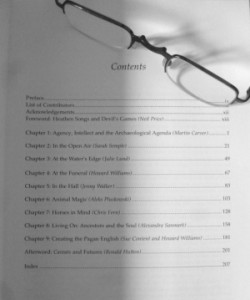
In the foreword Professor Martin Carver provides a coherent summary of the problems of understanding Anglo-Saxon mentalities from archaeological data and a good overview of the ideas that might lead to solutions, as well as adding insightful comments of his own. Ronald Hutton’s afterword brackets the essays with his warning on the potential limits of our knowledge and the potential of the research which is a sobering round off to the wide ranging content of the book.
Carver, M., Sanmark A., Semple S. (eds), 2010. Signals of Belief in Early England, Anglo-Saxon Paganism Revisited. Oxbow Books. Oxford.
There’s a useful overview of Thanet’s Anglo-Saxon archaeology on our Virtual Museum website and wider overview in Ges Moody’s book The Isle of Thanet from Prehistory to the Norman Conquest. The landing of Augustine in Thanet and the effect on the contemporary Anglo-Saxon culture of Thanet is dealt with in depth in St Augustine’s First Footfall, also by Ges Moody and published by the Trust for Thanet Archaeology.
Why have so many holes and voids opened up all over Thanet in the recent rainy weather?
That’s the question people keep asking us and we’ve seen plenty of evidence recently that Thanet’s rich underground world has surprises to reveal.
But, should we find it so unusual. Thanet’s chalk geology was a source of lime for Brick making and spreading on fields, tunnels and mines were cut through the solid chalk and air raid shelters, stores and drains were dug all over the Isle. The ground beneath us holds many subterranean secrets.
Many of these were forgotten when their entrances were lost or covered over. Some underground sites have stayed hidden for many decades until finally the wet weather washing away the crumbling chalk has brought these hidden sites to our attention.

Underground Thanet by Rod LeGear, a small book published by the Trust, gives a great round up of the hidden world of caves, tunnels and other voids in the chalk that lies beneath our feet.
A few copies of the first edition of this book are still available to order from our website. If you really want to know about Thanet’s Underground heritage its a great place to start finding out.
Underground Thanet is available for £8.00 +£2.00 post and can be ordered now with secure online PayPal payment, no PayPal account needed.
To order by post use our mail order form which you can get from here: Order form